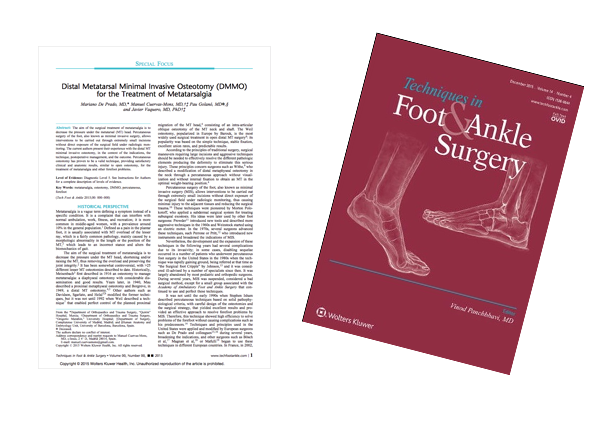Mariano de Prado,MD, * Manuel Cuervas-Mons, MD,Pau Golanó, MD, + and Javier Vaquero, MD
From the *Department of Orthopaedics and Trauma Surgery, “Quirón” Hospital, Murcia; Department of Orthopaedics and Trauma Surgery, “Gregorio Marañón,” University Hospital; Department of Surgery, Complutense University of Madrid, Madrid; and Human Anatomy and Embryology Unit, University of Barcelona, Barcelona, Spain.
+ Deceased

Abstract
The aim of the surgical treatment of metatarsalgia is to decrease the pressure under the metatarsal (MT) head. Percutaneous surgery of the foot, also known as minimal invasive surgery, allows interventions to be carried out through extremely small incisions without direct exposure of the surgical field under radiologic monitoring. The current authors present their experience with the distal MT minimal invasive osteotomy, in the context of the indications, the technique, postoperative management, and the outcome. Percutaneous osteotomy has proven to be a valid technique, providing satisfactory clinical and anatomic results, similar to open osteotomy, for the treatment of metatarsalgia and other forefoot problems.
Level of Evidence
Diagnostic: Level 5. See Instructions for Authors for a complete description of levels of evidence.
Key Words
metatarsalgia, osteotomy, DMMO, percutaneous, forefoot
Resumen
La clave del tratamiento quirúrgico de la metatarsalgia es reducir la presión bajo la cabeza metatarsiana. La cirugía percutánea del pie, también conocida como cirugía mínimamente invasiva, permite que la intervención se lleve a cabo a través de una incisión extremadamente pequeña sin exposición directa del campo quirúrgico bajo monitorización radiológica. Los autores presentan su experiencia con la osteotomía distal metatarsiana mínimamente invasiva, bajo los contextos de las indicaciones, las técnicas, el tratamiento del post operatorio y el resultado. La osteotomía percutánea ha demostrado ser una técnica válida, obteniendo resultados clínicos y anatómicos satisfactorios, similares a los de una osteotomía abierta, para el tratamiento de la metatarsalgia y otros problemas del ante pié.
Nivel de evidencia
Diagnóstico: Nivel 5. Ver instrucciones del autor para una descripción completa de los niveles de evidencia.
Palabras clave
metatarsalgia, osteotomia, ODMMI, percutáneo, ante pié
Techniques in Foot&AnkleSurgery (2015) 00
WoltersKluwerHealth, Inc. 2015
Doi: 10.1097/BTF.0000000000000093